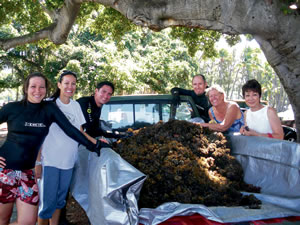Fighting Back Against Invasive Limu

Cleanup volunteers with a truckload of invasive seaweed in Waikiki
They first reared their ugly heads 38 years ago in windward Oahu and smothered coral and reefs in Kaneohe. Then they quietly surfaced and blanketed acres of reef at Maunalua Bay in Hawaii Kai. Now the slow-growing but deadly species are suffocating parts of Waikiki Beach.
They’re not animals – in fact, they’re killing ocean life too. They’re invasive algae known as Leather Mudweed (Arainvillea amaldepha) and Gorilla Seaweed (Gracilaria salicornia). Scientists say they need to be controlled before they cause an environmental crisis.
Gorilla Seaweed was introduced to Waikiki Beach and Kaneohe Bay in 1974 by a University of Hawaii-Manoa scientist who believed the species had the potential to be a money maker. The aquaculture business never took off but the algae did and exploded on our reefs as far away as Molokai.
On Prince Kuhio Day, more than a thousand pounds of the invasive algae were removed from the reef near the Waikiki Aquarium, which helped organize the cleanup effort. The UH Botany Department and employees from Hard Rock Café assisted in the project along with several other volunteers.
“This is a multi-year project with many partners, and we’ve been working to make these reefs healthier by removing these alien algae and their biomass,” said Dr. Celia Smith, University of Hawaii botany professor. “It’s also clear that the fish don’t eat these alien species, so if we want to have healthy reefs, we need to have native species.”
Young volunteers see things in a much simpler light.
“We’re here to help the ocean and make it cleaner,” says 10-year-old Kanoeanuhea Onaha, who was part of an army of 65 volunteers who worked in the area from the Aquarium to the Natatorium.
“We’re here to help the natives,” added 10-year-old Jordan Ho.
Jordan isn’t too far off. Leather Mudweed and Gorilla Seaweed are wiping out more than 85 different types of native species. Scientists say the Gorilla in particular now accounts for nearly all of the bottom cover in infested areas.
“The impact that these aliens have had has meant that we’ve lost of lot of our native species that used to be here, and collected by a lot of local people, are not available anymore,” says Smith.
She adds that local residents don’t enjoy the taste of these two types of invasive limu.
Over the past decade, more than 100 tons of the invasive algae have been removed from Oahu’s reefs, including a $3.5 million project in the reefs off Hawaii Kai and Kuliouou. Smith calls these species eco-system changers.
The algae removed from the Waikiki reef was handed over to the Honolulu Zoo where it will be composted for soil enrichment.
“They mix it in their material, so we have a very sustainable, local product this is involving school kids from Jefferson Elementary School and new partners like Aqua Resorts,” said Smith. “It’s a great feeling to have stuff like this go on.”
The limu forms in large, spiny clumps that move back and forth with tides, currents and surf, crushing native species, corals and reef. Smith says while they grow slowly, it doesn’t take much for them to quickly expand. And when it does, the species can change everything from sand to water flow.
“Every tide will take another piece somewhere else,” says Smith. “These plants propagate readily from very small pieces, and they don’t die when they come up on the beach. The tides can pick them back up and move them around, so it’s very important to get the bio-mass out.”
Volunteers say the next scheduled cleanup effort here will be in June.
“This is a periodic event, we run them about one every quarter,” says Smith. “We have Hawaii Community Foundation funding right now on this community restoration project. But long term we’ve been doing these since 2002. Eventually we hope that kind of removal will have some impact, that the native species will be able to be more competitive as we get that very intense competitor out of the reefs.”





